What are the key challenges in education today, and how can they be addressed at both local and global levels?
Education is a cornerstone of societal progress, economic development, and individual empowerment. However, as we progress through the 21st century, educational systems worldwide face numerous challenges that require innovative solutions at both local and global levels. This essay aims to explore the key challenges in education today and discuss potential approaches to address them, presenting a balanced view that considers multiple perspectives.
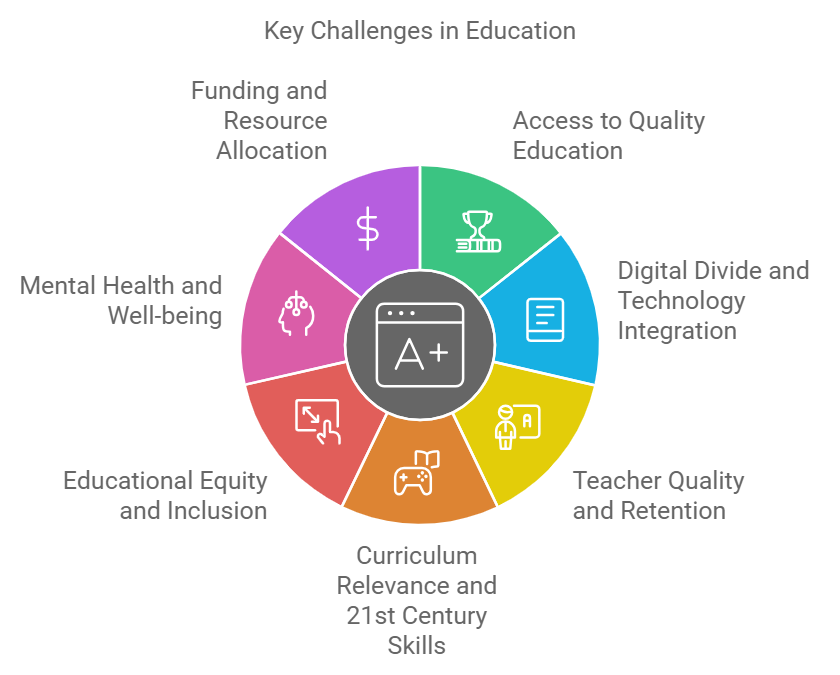
1. Access to Quality Education
One of the most pressing challenges in education today is ensuring equitable access to quality education for all. According to UNESCO (2023), approximately 258 million children and youth were out of school in 2018, with the situation likely exacerbated by the COVID-19 pandemic. This challenge is particularly acute in developing countries and among marginalized communities.
Local Solutions:
- Implementing targeted scholarship programs for underprivileged students
- Developing community-based learning centers in remote areas
- Leveraging technology for distance learning initiatives
Global Solutions:
- Increasing international aid for education in developing countries
- Promoting global partnerships for educational resource sharing
- Implementing policies to achieve Sustainable Development Goal 4: Quality Education
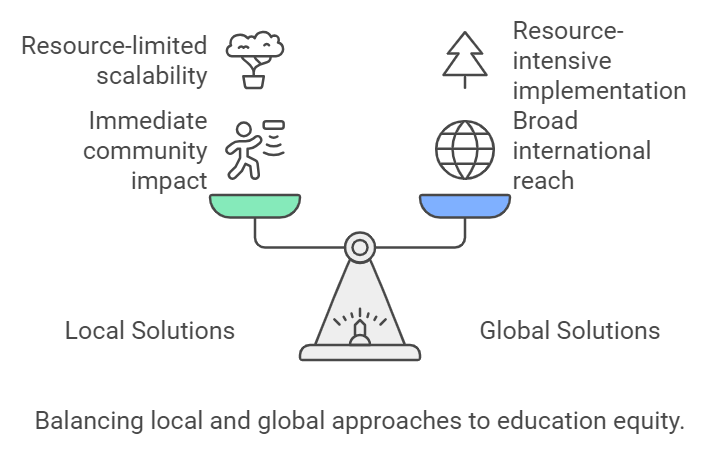
Alternative Perspective:
Some argue that focusing on access may compromise quality. Hanushek and Woessmann (2010) suggest that merely increasing enrollment without addressing educational quality might not lead to significant economic benefits. They argue for a balanced approach that emphasizes both access and quality improvement.
2. Digital Divide and Technology Integration
The rapid advancement of technology has created both opportunities and challenges in education. While digital tools can enhance learning experiences, they also widen the gap between those with access to technology and those without.
Local Solutions:
- Providing subsidized devices and internet access to low-income students
- Training teachers in effective use of educational technology
- Developing offline digital resources for areas with limited connectivity
Global Solutions:
- Investing in global digital infrastructure
- Creating open-source educational platforms accessible worldwide
- Establishing international standards for digital literacy
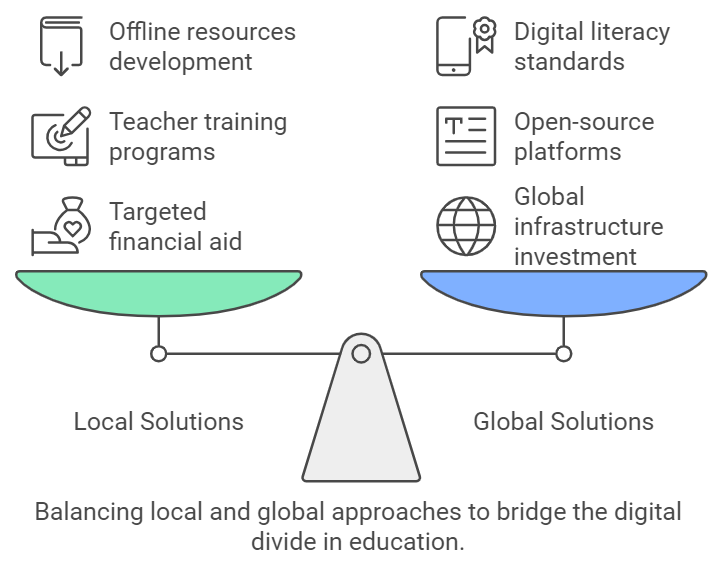
Alternative Perspective:
Critics argue that over-reliance on technology may lead to decreased social skills and attention spans. Spitzer (2014) warns about potential negative effects of digital media on cognitive development. This perspective suggests a need for balanced integration of technology in education.
3. Teacher Quality and Retention
The quality of education is intrinsically linked to the quality of teachers. However, many countries face challenges in attracting, retaining, and developing high-quality educators.
Local Solutions:
- Implementing competitive salary structures and benefits for teachers
- Providing ongoing professional development opportunities
- Creating mentorship programs for new teachers
Global Solutions:
- Developing international teacher exchange programs
- Establishing global standards for teacher education and certification
- Creating a global platform for sharing best practices in teaching
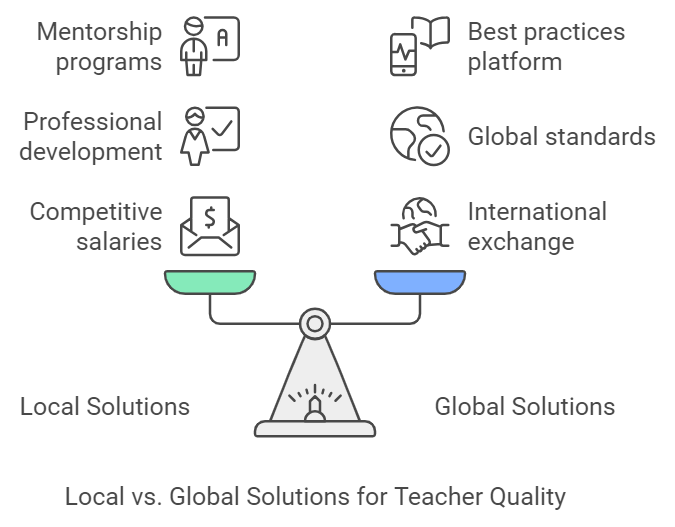
Alternative Perspective:
Some argue that focusing too much on teacher quality may lead to an over-standardized approach to education. Zhao (2018) contends that excessive emphasis on teacher effectiveness metrics can stifle creativity and innovation in teaching. This view suggests a need for balancing standardization with individual teacher autonomy.
4. Curriculum Relevance and 21st Century Skills
As the world rapidly changes, ensuring that educational curricula remain relevant and equip students with necessary 21st-century skills is a significant challenge.
Local Solutions:
- Regularly updating curricula with input from industry experts
- Integrating project-based learning and real-world problem-solving
- Emphasizing critical thinking, creativity, and digital literacy in assessments
Global Solutions:
- Developing international frameworks for 21st-century skills
- Promoting cross-cultural competencies in global curricula
- Establishing global platforms for sharing curriculum innovations
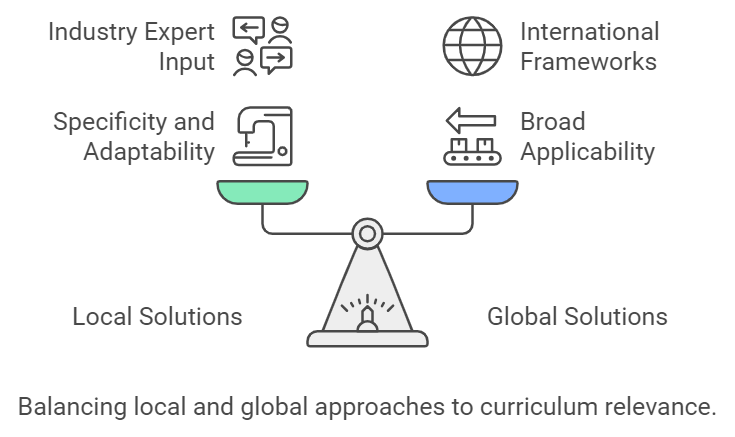
Alternative Perspective:
Critics argue that an excessive focus on 21st-century skills may come at the expense of traditional academic knowledge. Hirsch (2016) advocates for a knowledge-rich curriculum, arguing that broad general knowledge is crucial for developing critical thinking skills. This perspective suggests a need for balance between skills-based and knowledge-based approaches.
5. Educational Equity and Inclusion
Addressing disparities in educational outcomes based on factors such as socioeconomic status, race, gender, and disability remains a significant challenge.
Local Solutions:
- Implementing inclusive education policies in schools
- Providing targeted support for students from disadvantaged backgrounds
- Training teachers in culturally responsive pedagogy
Global Solutions:
- Developing international guidelines for inclusive education
- Sharing best practices for addressing educational disparities
- Promoting global awareness of diversity and inclusion in education
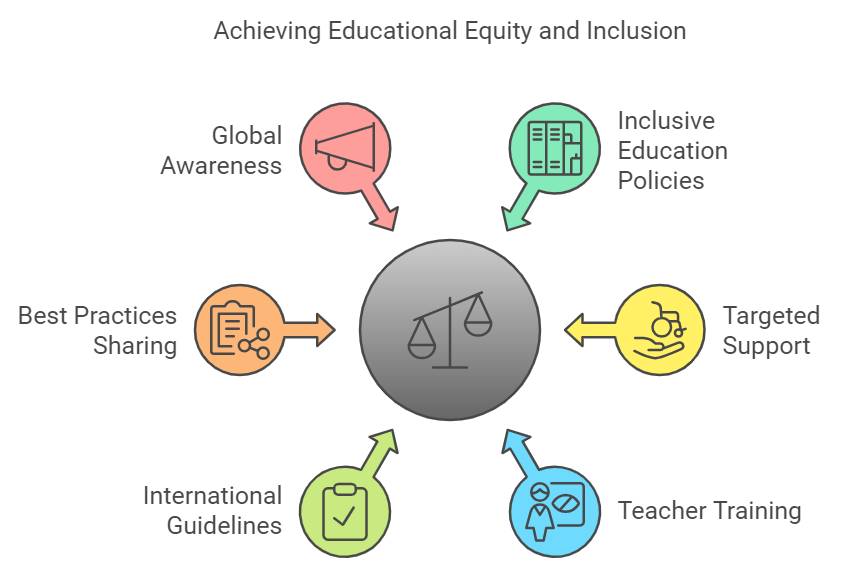
Alternative Perspective:
Some argue that focusing too much on equity may lead to a lowering of standards. Sander and Taylor Jr (2012) suggest that affirmative action policies in higher education can sometimes lead to mismatches between students and institutions. This perspective emphasizes the need for balancing equity efforts with maintaining high academic standards.
6. Mental Health and Well-being
The increasing prevalence of mental health issues among students poses a significant challenge to educational systems worldwide.
Local Solutions:
- Integrating mental health education into school curricula
- Providing on-site counseling services in schools
- Training teachers to recognize and respond to mental health issues
Global Solutions:
- Developing international standards for school-based mental health support
- Creating global awareness campaigns on student mental health
- Promoting research and knowledge sharing on effective interventions
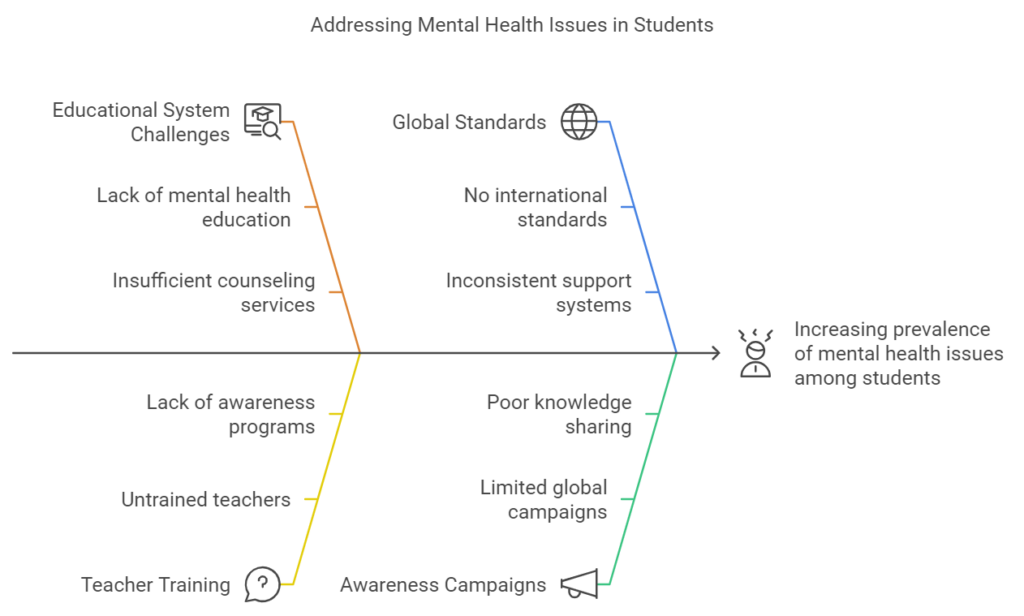
Alternative Perspective:
Some argue that an excessive focus on mental health in schools may pathologize normal developmental experiences. Ecclestone and Hayes (2009) warn against the “therapeutic education” trend, suggesting it might undermine students’ resilience. This view emphasizes the need for a balanced approach that supports mental health without over-medicalizing education.
7. Funding and Resource Allocation
Inadequate funding and inefficient resource allocation continue to hinder educational progress in many parts of the world.
Local Solutions:
- Implementing performance-based funding models for schools
- Encouraging public-private partnerships in education
- Optimizing resource allocation through data-driven decision making
Global Solutions:
- Increasing international aid for education in low-income countries
- Developing global guidelines for efficient educational resource allocation
- Promoting innovative financing mechanisms for education

Alternative Perspective:
Critics argue that market-based approaches to educational funding may exacerbate inequalities. Ravitch (2016) contends that school choice and privatization efforts can lead to increased segregation and disparities. This perspective suggests a need for balancing efficiency with equity in educational funding.
Conclusion
Addressing the key challenges in education today requires a multifaceted approach that considers both local contexts and global trends. While solutions such as increasing access to quality education, bridging the digital divide, improving teacher quality, updating curricula, promoting equity and inclusion, supporting mental health, and optimizing resource allocation are crucial, it’s important to consider alternative perspectives that highlight potential drawbacks or unintended consequences of these approaches.
A balanced approach to educational reform should aim to:
- Increase access while maintaining and improving quality
- Integrate technology thoughtfully without neglecting traditional skills and social development
- Support teacher effectiveness while preserving autonomy and creativity
- Develop 21st-century skills alongside a strong foundation of knowledge
- Promote equity and inclusion while maintaining high academic standards
- Support mental health without over-medicalizing the educational experience
- Optimize funding and resource allocation while ensuring equitable distribution
By considering multiple perspectives and striving for balance, educational systems can evolve to meet the needs of diverse learners in an ever-changing global landscape. The path forward requires ongoing dialogue, research, and collaboration among educators, policymakers, students, and communities at both local and global levels.
Addressing these challenges requires a combination of local and global efforts, with governments, communities, educational institutions, international organizations, and individuals working together to create a more equitable and effective education system worldwide. Many regions and communities around the world lack access to quality education, especially in remote or economically disadvantaged areas. This leads to unequal opportunities and perpetuates social and economic disparities. Governments and local authorities can invest in building schools and educational infrastructure in underserved areas. Additionally, providing financial support to families in need and offering scholarships can help students access quality education. International organizations and developed nations can support educational initiatives in developing countries through funding, technology transfer, and sharing best practices. The availability of well-trained and motivated teachers is critical for effective learning. However, many regions face a shortage of qualified teachers and struggle to retain them. Investing in teacher training programs, offering competitive salaries and benefits, and creating a supportive work environment can help attract and retain skilled educators. Collaboration among countries to share teaching methodologies and best practices can enhance teacher quality worldwide. International organizations can also support the training of teachers in developing regions. While technology offers numerous opportunities to enhance learning, there are challenges in providing equal access to technology and ensuring its effective integration into the educational process. Schools and institutions can invest in technology infrastructure and ensure equitable access to digital resources. Teachers can receive training in using technology effectively in the classroom. Organizations can collaborate to develop and distribute educational technology solutions that are accessible, culturally relevant, and adaptable to various educational settings. Marginalized groups, including girls, minorities, and individuals with disabilities, often face barriers to accessing education and may experience discrimination within educational settings.
Implementing inclusive policies, providing support services for marginalized students, and creating safe and welcoming learning environments can help address these issues. Advocacy by international organizations and cooperation among governments can promote inclusive educational policies and address systemic barriers to education. Insufficient funding for education can hinder the development of proper infrastructure, provision of learning materials, and teacher training. Governments can prioritize education in budget allocation, and communities can engage in fundraising efforts to support local schools. International aid and financial support can assist countries with limited resources in improving their educational systems. Education needs to adapt to the changing demands of the modern world, ensuring that students acquire skills relevant to their future careers and personal development. Regularly reviewing and updating curricula to align with current trends and needs can help improve educational relevance. Collaboration between educational institutions and industry leaders can inform curricular development to meet global job market demands. The COVID-19 pandemic highlighted the difficulties in transitioning to remote learning for many students, particularly those without access to digital devices and stable internet connections. Providing resources like tablets or laptops to students, offering offline learning materials, and leveraging radio or television for educational broadcasts can bridge the digital divide. Organizations can work together to ensure that remote learning solutions are accessible to all, including through the development of affordable and reliable internet infrastructure in remote areas. Overemphasis on standardized testing can lead to a narrow focus on rote memorization and may not adequately measure essential skills and competencies. Encouraging diverse assessment methods, such as project-based evaluations and practical demonstrations of learning, can provide a more holistic view of student capabilities. Educational experts and policymakers can collaborate to develop alternative assessment models that focus on skills relevant to the 21st-century workforce.
References
Ecclestone, K., & Hayes, D. (2009). The Dangerous Rise of Therapeutic Education. Routledge.
Hanushek, E. A., & Woessmann, L. (2010). Education and Economic Growth. In P. Peterson, E. Baker, & B. McGaw (Eds.), International Encyclopedia of Education (Vol. 2, pp. 245-252). Elsevier.
Hirsch, E. D. (2016). Why Knowledge Matters: Rescuing Our Children from Failed Educational Theories. Harvard Education Press.
Ravitch, D. (2016). The Death and Life of the Great American School System: How Testing and Choice Are Undermining Education. Basic Books.
Sander, R. H., & Taylor Jr, S. (2012). Mismatch: How Affirmative Action Hurts Students It’s Intended to Help, and Why Universities Won’t Admit It. Basic Books.
Spitzer, M. (2014). Information Technology in Education: Risks and Side Effects. Trends in Neuroscience and Education, 3(3-4), 81-85.
UNESCO. (2023). Education: From disruption to recovery. https://en.unesco.org/covid19/educationresponse
Zhao, Y. (2018). What Works May Hurt: Side Effects in Education. Teachers College Press.